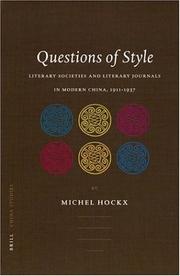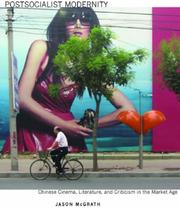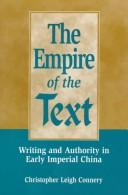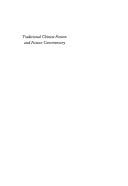| Listing 1 - 10 of 27 | << page >> |
Sort by
|
Book
ISBN: 0231541538 9780231541534 9780231166133 9780231166126 Year: 2016 Publisher: New York, NY : Columbia University Press,
Abstract | Keywords | Export | Availability | Bookmark
 Loading...
Loading...Choose an application
- Reference Manager
- EndNote
- RefWorks (Direct export to RefWorks)
Li Zhi's iconoclastic interpretations of history, religion, literature, and social relations have fascinated Chinese intellectuals for centuries. His approach synthesized Confucian, Buddhist, and Daoist ethics and incorporated the Neo-Confucian idealism of such thinkers as Wang Yangming (1472–1529). The result was a series of heretical writings that caught fire among Li Zhi's contemporaries, despite an imperial ban on their publication, and intrigued Chinese audiences long after his death. Translated for the first time into English, Li Zhi's bold challenge to established doctrines will captivate anyone curious about the origins of such subtly transgressive works as the sixteenth-century play The Peony Pavilion or the eighteenth-century novel Dream of the Red Chamber. In A Book to Burn and a Book to Keep (Hidden), Li Zhi confronts accepted ideas about gender, questions the true identity of history's heroes and villains, and offers his own readings of Confucius, Laozi, and the Buddha. Fond of vivid sentiment and sharp expression, Li Zhi made no distinction between high and low literary genres in his literary analysis. He refused to support sanctioned ideas about morality and wrote stinging social critiques. Li Zhi praised scholars who risked everything to expose extortion and misrule. In this sophisticated translation, English-speaking readers encounter the best of this heterodox intellectual's vital contribution to Chinese thought and culture.
Book
ISBN: 3598245467 9783598245466 Year: 2007 Publisher: München K.G. Saur
Abstract | Keywords | Export | Availability | Bookmark
 Loading...
Loading...Choose an application
- Reference Manager
- EndNote
- RefWorks (Direct export to RefWorks)
S16/0100 --- S16/0150 --- S16/0180 --- S16/0190 --- China: Literature and theatrical art--Bibliographies, dictionaries, yearbooks and collections --- China: Literature and theatrical art--General works --- China: Literature and theatrical art--Stylistics --- China: Literature and theatrical art--Literary criticism
Book
ISBN: 9781939161581 1939161584 9781939161789 1939161789 1942242786 Year: 2015 Publisher: Ithaca, New York : Cornell University East Asia Program,
Abstract | Keywords | Export | Availability | Bookmark
 Loading...
Loading...Choose an application
- Reference Manager
- EndNote
- RefWorks (Direct export to RefWorks)
The first book-length study of Wang Wenxing in English offering biographic, cultural, textual, literary, and linguistic readings of his work. The essays cover topics such as Wang's writing principles, typology of characters, analysis of lexicon, employment of stream-of-consciousness, musicality, relationship to Modernist writers of the West, relationship to Lu Xun, and issues of translating Wang's works into Western languages. Original contributions by Wang Wenxing illuminates his own writing through a discussion of his way of reading, and a biographical essay by Ch'en Chu-yun, his wife, who shares with the reader moments in their private life and the writing habits of her husband. In addition, this manuscript appends outlines of Wang's novels and bibliographies that are valuable to both students and scholars in their studies of Wang Wenxing's writing in particular as well as to the understanding of Taiwanese and Chinese literatures in general.
Wang, Wenxing, --- Wang, Wen-hsing, --- Wen-Hsing, Wang, --- 王文兴, --- 王文興, --- Criticism and interpretation. --- Translations --- History and criticism. --- S05/0221 --- S16/0190 --- China: Biographies and memoirs--20th century: individuals --- China: Literature and theatrical art--Literary criticism --- Chinese literature
Book
ISSN: 07552513 ISBN: 2745301721 Year: 1999 Publisher: Paris Champion
Abstract | Keywords | Export | Availability | Bookmark
 Loading...
Loading...Choose an application
- Reference Manager
- EndNote
- RefWorks (Direct export to RefWorks)
Book
ISBN: 0231547587 9780231547581 9780231187947 0231187947 Year: 2018 Publisher: New York, NY : Columbia University Press,
Abstract | Keywords | Export | Availability | Bookmark
 Loading...
Loading...Choose an application
- Reference Manager
- EndNote
- RefWorks (Direct export to RefWorks)
Emotion takes place. Rather than an interior state of mind in response to the outside world, emotion per se is spatial, at turns embedding us from without, transporting us somewhere else, or putting us ahead of ourselves. In this book, Ling Hon Lam gives a deeply original account of the history of emotions in Chinese literature and culture centered on the idea of emotion as space, which the Chinese call "emotion-realm" (qingjing).Lam traces how the emotion-realm underwent significant transformations from the dreamscape to theatricality in sixteenth- to eighteenth-century China. Whereas medieval dreamscapes delivered the subject into one illusory mood after another, early modern theatricality turned the dreamer into a spectator who is no longer falling through endless oneiric layers but pausing in front of the dream. Through the lens of this genealogy of emotion-realms, Lam remaps the Chinese histories of morals, theater, and knowledge production, which converge at the emergence of sympathy, redefined as the dissonance among the dimensions of the emotion-realm pertaining to theatricality.The book challenges the conventional reading of Chinese literature as premised on interior subjectivity, examines historical changes in the spatial logic of performance through media and theater archaeologies, and ultimately uncovers the different trajectories that brought China and the West to the convergence point of theatricality marked by self-deception and mutual misreading. A major rethinking of key terms in Chinese culture from a comparative perspective, The Spatiality of Emotion in Early Modern China develops a new critical vocabulary to conceptualize history and existence.
Chinese drama --- Space perception in literature --- Emotions in literature. --- Chinese literature. --- History and criticism. --- Emotions in literature --- S16/0190 --- S16/0195 --- History and criticism --- China: Literature and theatrical art--Literary criticism --- China: Literature and theatrical art--Thematic studies
Book
ISBN: 0226486923 Year: 1975 Publisher: Chicago, Ill.
Abstract | Keywords | Export | Availability | Bookmark
 Loading...
Loading...Choose an application
- Reference Manager
- EndNote
- RefWorks (Direct export to RefWorks)
Chinese literature --- History and criticism --- Theory, etc --- S16/0160 --- S16/0190 --- -China: Literature and theatrical art--General works on traditional literature --- China: Literature and theatrical art--Literary criticism --- -Theories, etc --- Theories, etc. --- History and criticism&delete& --- Theories, etc --- China: Literature and theatrical art--General works on traditional literature

ISBN: 9004129154 9004205675 9004228640 Year: 2003 Volume: 2 Publisher: Leiden Brill
Abstract | Keywords | Export | Availability | Bookmark
 Loading...
Loading...Choose an application
- Reference Manager
- EndNote
- RefWorks (Direct export to RefWorks)
Dealing with the central issue of style in literature, this groundbreaking study is a must for sinologists, but also for all students of comparative literature. Michel Hockx takes as a point of departure the observation that most writers of the Republican period adhered to a distinctly traditional practice of gathering in literary societies, while at the same time displaying a marked preference for publishing their works through the modern medium of the literary journal. The first part of the book analyses different types of societies and their journals. The case studies in part two convey the wider impact of literary collectives and journal publications on literary practice. Convincingly breaking with the 'May Fourth' paradigm, the author proposes a radically new way of understanding the relationship between New Literature and other styles of modern Chinese writing.
S16/0170 --- S16/0190 --- Chinese literature --- -Chinese literature --- -China: Literature and theatrical art--General works on modern literature --- China: Literature and theatrical art--Literary criticism --- Societies, etc --- Periodicals --- History and criticism --- China: Literature and theatrical art--General works on modern literature --- Chinese literature. --- Societies, etc. --- History and criticism. --- 1900-1999

ISBN: 9780804773638 9780804758741 0804773637 0804758743 Year: 2008 Publisher: Stanford, Calif. : Stanford University Press,
Abstract | Keywords | Export | Availability | Bookmark
 Loading...
Loading...Choose an application
- Reference Manager
- EndNote
- RefWorks (Direct export to RefWorks)
"This book examines Chinese culture in the age of market reforms. Beginning in the early 1990s and on into the new century, fields such as literature and film have been fundamentally transformed by the forces of the market as China is integrated ever more closely into the world economic system. As a result, the formerly unified revolutionary culture has been changed into a pluralized state that reflects the diversity of individual experience in the reform era. New autonomous forms of culture that have arisen include avant-garde as well as commercial literature, and independent film as well as a new entertainment cinema. Chinese people find their experiences of postsocialist modernity reflected in all kinds of new cultural products as well as critical debates that often question the direction of Chinese society in the midst of comprehensive and rapid change."--BOOK JACKET.
Popular culture --- Motion pictures --- Culture in motion pictures. --- Culture populaire --- Cinéma --- Culture au cinéma --- S17/2000 --- S16/0190 --- S02/0200 --- China: Art and archaeology--Film --- China: Literature and theatrical art--Literary criticism --- China: General works--Civilization and culture --- Cinéma --- Culture au cinéma --- Culture in motion pictures --- Sociologie van de cultuur --- Film --- China

ISBN: 0847687392 0847687384 Year: 1998 Publisher: Totowa Rowman & Littlefield
Abstract | Keywords | Export | Availability | Bookmark
 Loading...
Loading...Choose an application
- Reference Manager
- EndNote
- RefWorks (Direct export to RefWorks)
S16/0150 --- S16/0190 --- S16/0195 --- China: Literature and theatrical art--General works --- China: Literature and theatrical art--Literary criticism --- China: Literature and theatrical art--Thematic studies --- Chinese literature --- Intertextuality. --- Literature and society --- History and criticism --- theory, etc. --- Intertextuality --- Literature --- Literature and sociology --- Society and literature --- Sociology and literature --- Sociolinguistics --- Criticism --- Semiotics --- Influence (Literary, artistic, etc.) --- History and criticism&delete& --- theory, etc --- Social aspects

ISBN: 0804727201 Year: 1997 Publisher: Stanford (Calif.) : Stanford university press,
Abstract | Keywords | Export | Availability | Bookmark
 Loading...
Loading...Choose an application
- Reference Manager
- EndNote
- RefWorks (Direct export to RefWorks)
S16/0160 --- S16/0195 --- S16/0190 --- Chinese fiction --- -Chinese fiction --- -Chinese literature --- China: Literature and theatrical art--General works on traditional literature --- China: Literature and theatrical art--Thematic studies --- China: Literature and theatrical art--Literary criticism --- Book reviews --- History and criticism --- Book reviews. --- History and criticism. --- -China: Literature and theatrical art--General works on traditional literature --- Chinese literature
| Listing 1 - 10 of 27 | << page >> |
Sort by
|

 Search
Search Feedback
Feedback About UniCat
About UniCat  Help
Help News
News